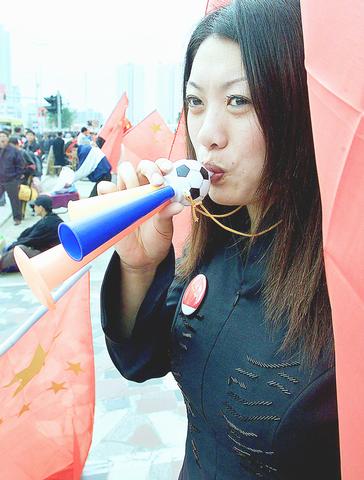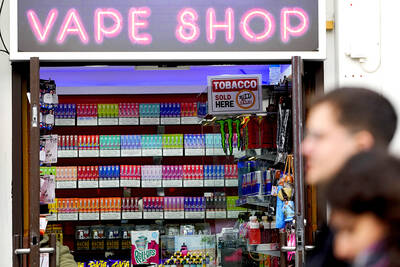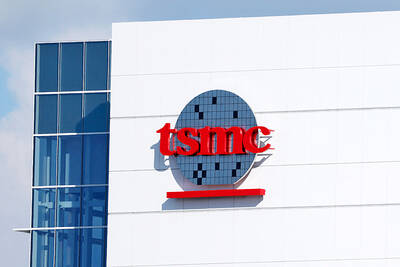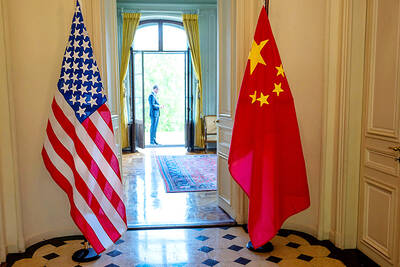China is Asia's safe haven for investors as its smaller neighbors succumb to the US-led global economic slowdown, but domestic risks remain, Holland-based bank ABN Amro said in a report.
The risks come from a projected fall in exports to the US as consumer confidence plummeted following the Sept. 11 terror attacks, and a slowdown in investment demand, it said.
"Relatively speaking, China is still the safe haven in the region thanks to a less trade-dependent economy. However, investors should not ignore the risk within," ABN Amro said.

PHOTO: AFP
China's low reliance on high-technology industries has insulated it from the fall-out of the slump in the world's electronics industry, even as the down-swing hammered its neighbors such as Singapore, Taiwan and Malaysia.
Its GDP growth far exceeds the rest of Asia and domestic demand is still robust, although many anlalysts question the reliability of statistics pumped out by Beijing.
But China sells a lot of consumer goods such as toys, sporting goods and footwear to the US and a fall in US consumer spending after the attacks on New York and Washigton is likely to affect these exports.
"It is worth noting that among the toys, sporting goods and footwear imported by the US, 60 percent are from China," the report said. The three items accounted for one fifth of the US's total imports from China.
"We expect China's exporters to be more seriously hit amid the slowdown of consumption demand in the US," it said.
Consumer spending accounts for two-thirds of US economic activity and has so far been the strongest pillar of growth.
ABN Amro said it has chopped its year 2002 export growth forecast for China from 15 percent to 3.5 percent.
China's projected GDP growth this year was also trimmed to 7.2 percent from 7.5 percent. In 2002, GDP is forecast at 7 percent, down from the original 8.5 percent.
"Apart from the expected slowdown in external demand, we also see initial signs of a slowdown in investment demand, which has been supported by the government's pump-priming over the past few years," the bank said.
Profit growth of industrial enterprises rose by 15.8 percent in the eight months to August this year, sharply down from 86 percent in the same period last year.
"Weakening profit growth is not able to support another year of strong investment growth. Furthermore, facing a slowdown in the global economy, people are more cautious about business expansion, leading to a slowdown in investment demand," it said.
Meanwhile, Standard Chartered Bank said China has carried out reforms better than the rest of the region and this was the main reason why it has attracted the bulk of foreign investments into Asia.
"The argument that China has been gaining foreign investment at the expense of the rest of Asia is flawed," Standard Chartered said in a report.
"While China is likely to continue to get the bulk of foreign investment inflow, globalization driven by comparative advantage means that foreign investment into Asia is a net sum gain," it said.
Standard Chartered compared both China and Japan which it said had similar economic problems and said that the giant communist nation "had so far pursued a better reform-growth policy mix than Japan and many other Asian countries."
For example, China has reformed its inefficient state-owned enterprises, which now produce less than 25 percent of total industrial output, down from more than 80 percent in the early 1980s.
And while the closure of the state-owned enterprises raised unemployment the effort is bearing fruit as the number of loss-making firms is falling and corporate profits rising, it said.

Real estate agent and property developer JSL Construction & Development Co (愛山林) led the average compensation rankings among companies listed on the Taiwan Stock Exchange (TWSE) last year, while contract chipmaker Taiwan Semiconductor Manufacturing Co (TSMC, 台積電) finished 14th. JSL Construction paid its employees total average compensation of NT$4.78 million (US$159,701), down 13.5 percent from a year earlier, but still ahead of the most profitable listed tech giants, including TSMC, TWSE data showed. Last year, the average compensation (which includes salary, overtime, bonuses and allowances) paid by TSMC rose 21.6 percent to reach about NT$3.33 million, lifting its ranking by 10 notches

Popular vape brands such as Geek Bar might get more expensive in the US — if you can find them at all. Shipments of vapes from China to the US ground to a near halt last month from a year ago, official data showed, hit by US President Donald Trump’s tariffs and a crackdown on unauthorized e-cigarettes in the world’s biggest market for smoking alternatives. That includes Geek Bar, a brand of flavored vapes that is not authorized to sell in the US, but which had been widely available due to porous import controls. One retailer, who asked not to be named, because

SEASONAL WEAKNESS: The combined revenue of the top 10 foundries fell 5.4%, but rush orders and China’s subsidies partially offset slowing demand Taiwan Semiconductor Manufacturing Co (TSMC, 台積電) further solidified its dominance in the global wafer foundry business in the first quarter of this year, remaining far ahead of its closest rival, Samsung Electronics Co, TrendForce Corp (集邦科技) said yesterday. TSMC posted US$25.52 billion in sales in the January-to-March period, down 5 percent from the previous quarter, but its market share rose from 67.1 percent the previous quarter to 67.6 percent, TrendForce said in a report. While smartphone-related wafer shipments declined in the first quarter due to seasonal factors, solid demand for artificial intelligence (AI) and high-performance computing (HPC) devices and urgent TV-related orders

MINERAL DIPLOMACY: The Chinese commerce ministry said it approved applications for the export of rare earths in a move that could help ease US-China trade tensions Chinese Vice Premier He Lifeng (何立峰) is today to meet a US delegation for talks in the UK, Beijing announced on Saturday amid a fragile truce in the trade dispute between the two powers. He is to visit the UK from yesterday to Friday at the invitation of the British government, the Chinese Ministry of Foreign Affairs said in a statement. He and US representatives are to cochair the first meeting of the US-China economic and trade consultation mechanism, it said. US President Donald Trump on Friday announced that a new round of trade talks with China would start in London beginning today,